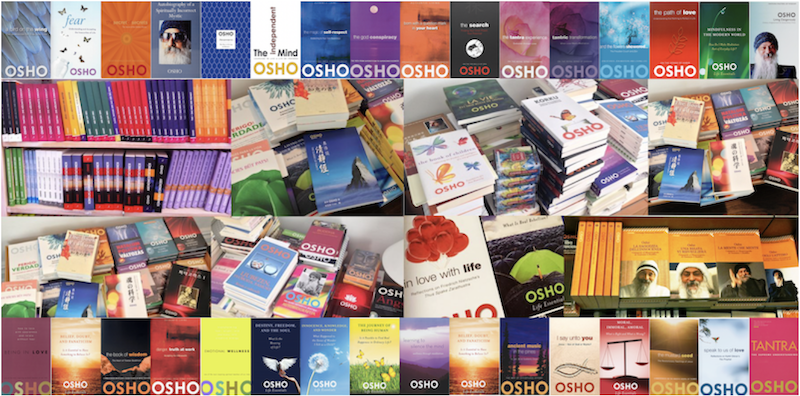By April 1989, when Osho gives his last public talk, Osho is already the most prolific non-fiction author of all time.
His thousands of hours of talks have been heard by hundreds of thousands of listeners around the world. Almost every talk, whether in Hindi or English, was recorded and then made available on tape. Each and every series of talks were transcribed and printed as books. There is no non-fiction author in history with about 500 titles to their name! Of the total of approximately 6000 talks, the last 1800 have also been videotaped.
By that time in 1989, Osho’s persistent exposure of the vested interests, and all their traditional beliefs, ideologies, and values, render him unpublishable. After leaving the USA in 1985 until his final departure in 1990, all the mainstream publishers who had previously published his works cancel all existing contracts. The books already in the market are withdrawn and pulped, and bookstore owners refuse to carry his books. His very public exposure of the Christian fascism that is so obvious today, was shocking then, and provoked a violent reaction to his work from the Reagan White House, detailed elsewhere. The rest of what was then called “the free world” followed suit.
The result was that no one would publish Osho’s books.
By 1992, Osho books had almost completely vanished from commercial bookshops, libraries, and public awareness. On Osho’s request in 1986, because no publisher would accept his works anymore, OIF established the Rebel Publishing House in Germany. For the ten years from the time of Osho leaving the USA until 1995, this was the only entity that published all of his ongoing talks in English – those held during the “World Tour” and the talks he gave during the remaining years in India until 1989.
Undaunted, the OSHO publishing team began the process of re-establishing Osho in the international publishing world. And succeeded.
It began in India, when RV Pandit, an award-winning film producer, publisher, anti-corruption crusader and political activist, began to promote Osho’s talks on the Sony Music label. In the pre-digital era, only audiocassette tapes were available.
Sony distributed some 400,000 audiocassettes of Osho’s talks on the subcontinent.
Industry figures confirmed that each tape was copied about 10 times, and then each copy listened to by another 10 people. With some 50 million listeners, Osho was second only to Michael Jackson in popularity at that time in India.
R.V. Pandit then proposed to the London-based CEO of Bertelsmann Global that they also carry Osho’s audio recordings. Based on Sony’s success he immediately said yes.
With the world’s two largest audio media publishers of that time carrying Osho content, the door opened for the Osho expression in all formats.
Now, over 25 years later Osho is carried worldwide by more than 200 publishing houses, who have sold over 28 million copies of his books.
In 2020, 411 publishing agreements were executed around the world, more than one per day. By contrast, at the time of Osho’s last public talk in early 1989 through to 1994, there were 33 publishing contracts signed.
There are currently 3,116 active licensing agreements, including translations in 53 languages, ranging from nearly 300 titles in Italian, nearly 200 in Russian to more than 40 in Arabic. Osho’s printed words are now everywhere. This work to make Osho available is an ongoing process, with translations of his work coming out almost daily, with more publishing contracts signed each day. This includes nearly 800 contracts in Indian languages, including 275 contracts in the original Hindi.
As Osho would often explain, his reason for speaking was not to convey anything “intellectual” but something existential. What he calls “the art of listening” – his revolutionary approach to meditation. An approach that fixes “the basic mistake” made by Zen, which he says, had “been working for almost fourteen centuries… totally devoted to a single thing and that is meditation.”
Osho explains: “I don’t speak to teach something; I speak to create something. These are not lectures. These are simply devices for you to become silent.”
So, of course, that makes Osho’s original archive of audio recordings a priceless contribution to the evolution of human consciousness.
Every audio recording has been compared with the existing transcription to confirm their accuracy. During this time a complete archive of talks in digital mp3 format was created in the early 2000s using advanced audio-enhancement tools. The resultant text archives in both English and Hindi have been published on the osho.com website as the OSHO Online Library
Originally only available through the OSHO International Shop, the original audio recordings of these Osho talks are now also available on Audible, the world’s largest audio distributor – including both individual talks and the whole series of talks.
The most challenging part of the process of preserving Osho’s work has been taking care of the video recordings. Originally filmed in many different formats over the years, they were first partially digitized in D2 format for safekeeping and best quality maintenance, and are now being transferred onto fully digitized formats where they can be seen now on YouTube.
In these last 25 years, from a climate in 1994 when the powers that be almost succeeded in rendering Osho invisible, it has been a dramatic transformation.
Today Osho’s books are available wherever there is a bookshop in almost every country in the world, and millions listen to his words every day.
About 100 million people in India read Osho’s words in the press every year, tens of millions of people have visited osho.com, and now 3 million people watch Osho on YouTube every month.
END

